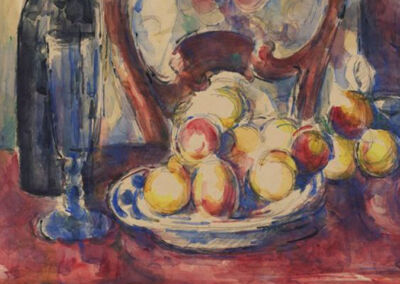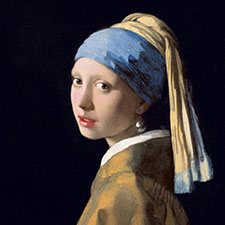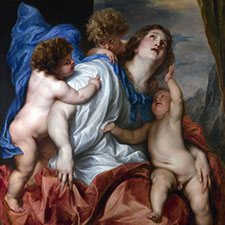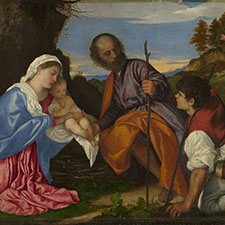Indigo
Natural organic pigmentComposition and Properties of Indigo
It is an organic pigment of very dark blue colour with the following chemical formula:

The pigment is not destroyed by dilute acids and alkalis and is the most lightfast of all the natural organic dyes. No incompatibilities have been reported for use in oil painting. It was employed in mixtures with yellow pigments such as orpiment or yellow ochre to produce a green color.
Collection of the historical dyes of the Technical University of Dresden, Germany

Pigment
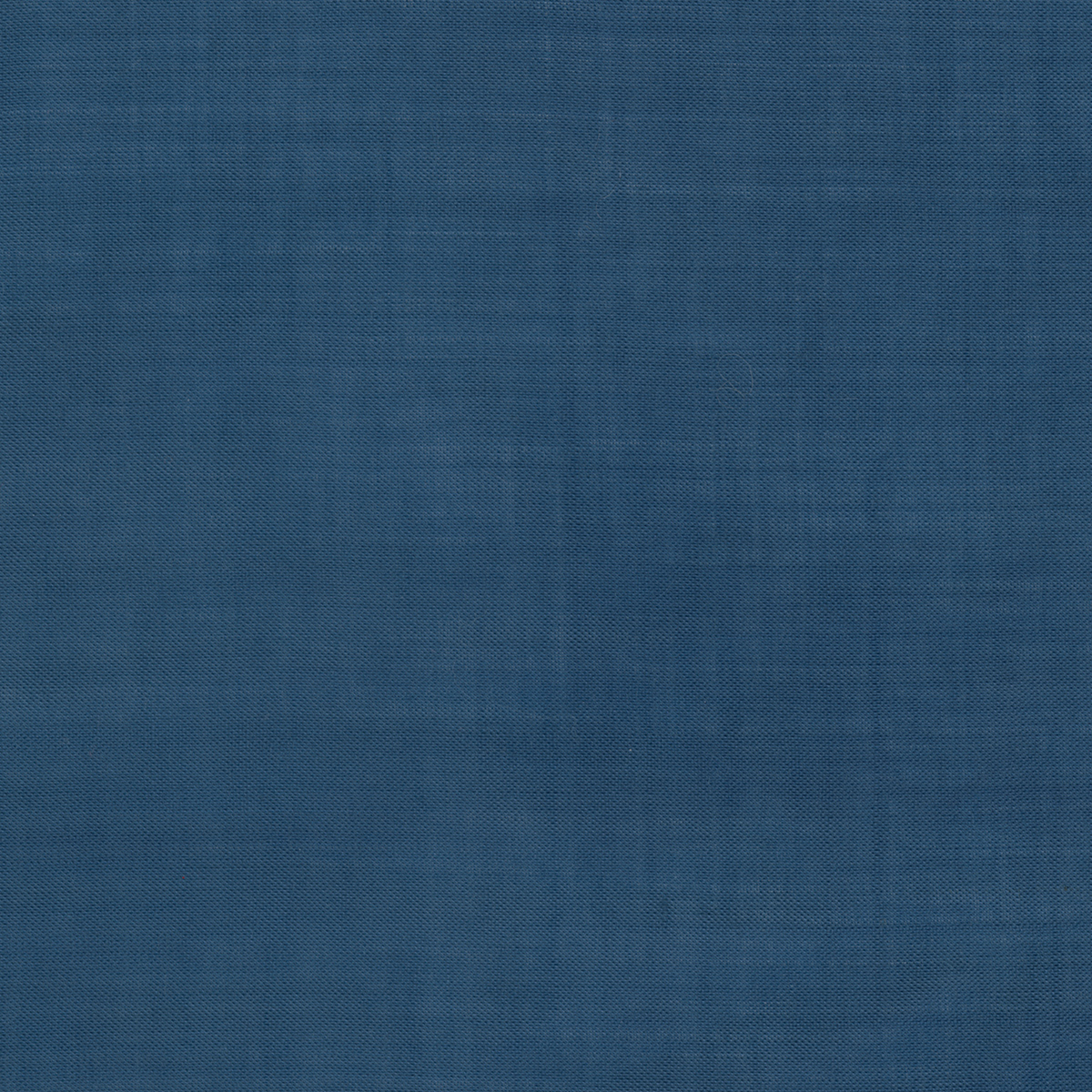
Painted swatch
Names
Alternative names
Woad
Color Index
Natural Indigo: NB 1, CI 75780
Synthetic Indigo: PB 66, CI 73000
Word origin
From Latin indicum “indigo,” from Greek indikon “blue dye from India,” literally “Indian (substance),” neuter of indikos “Indian,” from India.
From Online Etymology Dictionary
Indigo
German
Indigo
French
Indaco
Italian
Anil, indigo
Spanish
Preparation of Indigo
Preparation of the Natural Dye
The starting material for the preparation of this pigment is a multitude of plants. The plant Indigofera anil is found mainly in India and woad (Isatis tinctoria) grows in Europe.

Woad plant, Isatis tinctoria
The relevant substance contained in all of these plants is indican (indoxyl glucoside).

Indican
To separate the glucose rest (right part of the indican molecule above) from the indoxyl (on the left) the plant parts, e.g. leaves of woad are fermented for several weeks. The fermentation process brings about the cleavage of the glycoside bond and leads to a separation of the two parts of the indican molecule and to the isolation of indoxyl.

Indoxyl
Oxidation of indoxyl by atmospheric oxygen leads then to the final product.

Oxidation of indoxyl
Video: 'Setting up an Organic Indigo Dye Vat' by The Wild Dyery
Preparation of Synthetic Indigo
The first synthesis of indigo by Bayer and Emmerling dates back to 1870. Today indigo can be prepared industrially or in the laboratory from o-nitrobenzaldehyde and acetone. The laboratory preparation is an easy two-step synthesis and is often used in teaching organic chemistry (1,2).
References
(1) Deuber, R. and Lipscher, J. Herstellung von Indigo, Färbervorgang, SwissEduc
(2) Royal Society of Chemistry Website (Learn Chemistry), Microscale synthesis of indigo dye
Video: 'Indigo Dye Synthesis and Fabric Staining Experiment' by Scott Milam
History of Use
The pigment had been in use since antiquity but its use in oil painting ceased at the beginning of the eighteenth century. The following graph gives the frequency of its use in the paintings of the Schack Collection in the Bavarian State Art Collections in Munich (1).

References
(1) Kühn, H., Die Pigmente in den Gemälden der Schack-Galerie, in: Bayerische Staatsgemäldesammlungen (Ed.) Schack-Galerie (Gemäldekataloge Bd. II), München 1969.
(2) Clark, R. J. H.; Cooksey, C. J.; Daniels, M. A. M.; Withnall, R., Indigo, woad, and Tyrian Purple: important vat dyes from antiquity to the present. Endeavour 1993, 17 (4), 191-199. https://doi.org/10.1016/0160-9327(93)90062-8
(3) Mira S. de Roo, The Trade in Blue During the 17th Century: An Examination of Western European Pigment Trade in Azurite, Indigo, Lapis Lazuli, and Smalt During the 17th Century Through Works in the National Gallery, London, Master of Philosophy, University of Glasgow, 2004.
Examples of use
Antonis van Dyck, Lord John Stuart and his Brother, ca 1638
Lord Bernard’s blue satin dress: undermodelling is done in indigo in the shadows and indigo and lead white in the mid-tones. The surface was then scumbled (applying a very thin opaque layer of paint so that the underlying colour is still partly visible) with azurite and azurite mixed with indigo.
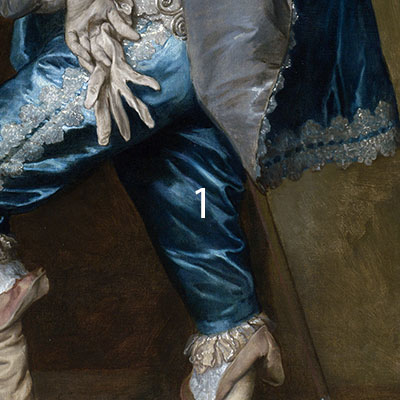
Johannes Vermeer, Christ in the House of Martha and Mary, 1654-5
The blue cloak of Christ is painted in indigo and the blue-green skirt of Mary contains indigo mixed with lead white and yellow ochre.
Video: 'The World’s Earliest Known Use of Indigo Dye Found in Peru' by wwwAAASorg
Identification
Fiber Optics Reflectance Spectrum (FORS)

Spectra by A. Cosentino, Cultural Heritage Science Open Source (CHSOS)
Infrared Spectrum
IR-spectrum at Coblentz Society, Inc., “Evaluated Infrared Reference Spectra” in NIST Chemistry WebBook, NIST Standard Reference Database Number 69, Eds. P.J. Linstrom and W.G. Mallard, National Institute of Standards and Technology, Gaithersburg.
Raman Spectrum
Raman spectrum in Howell G. M. Edwards, John M. Chalmers, Raman Spectroscopy in Archaeology and Art History, Royal Society of Chemistry, 2005.
X-Ray Fluorescence Spektrum (XRF)
XRF Spectrum in the Free XRF Spectroscopy Database of Pigments Checker, CHSOS website.
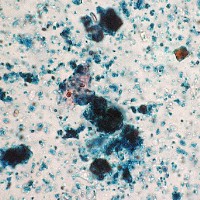
Microphotograph
image © Volker Emrath
Further Reading
References
(1) Schweppe, H., Indigo and Woad, in Artists’ Pigments. A Handbook of Their History and Characteristics, Vol. 3: FitzHugh, E.W. (Ed.) Oxford University Press 1997, p. 81 – 107. Available as pdf from the National Gallery of Art.
(2) Clark, R. J. H.; Cooksey, C. J.; Daniels, M. A. M.; Withnall, R., Indigo, woad, and Tyrian Purple: important vat dyes from antiquity to the present. Endeavour 1993, 17 (4), 191-199. https://doi.org/10.1016/0160-9327(93)90062-8
3. S. Muntwyler, J. Lipscher, HP. Schneider, Das Farbenbuch, 2nd. Ed., 2023, alataverlag Elsau, pp. 132-133, 216-217, and 392-401.






